Hearts and Flowers – Draw Freely with Me!
This week we will grab colored pencils and draw freely in full color. Follow me step by step!
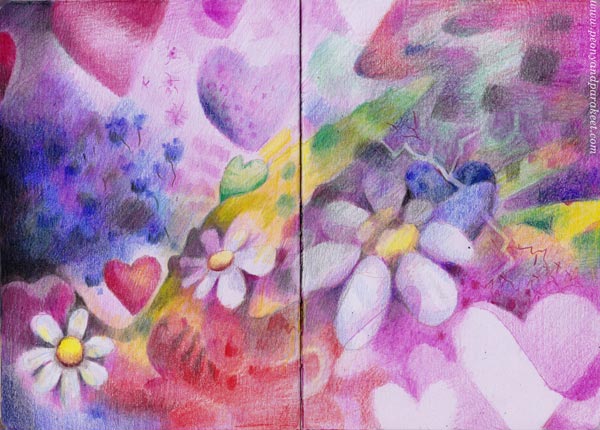
This exercise is set so that we start simple and then get more creative. If you are a beginner, you can stop earlier, and if you have more skills and patience, you can go to the very end. You only need paper and colored pencils. I drew the picture in my colored pencil journal.
Step 1 – Draw a Flower and a Heart
Pick a brown or blue colored pencil and draw a flower and a heart.
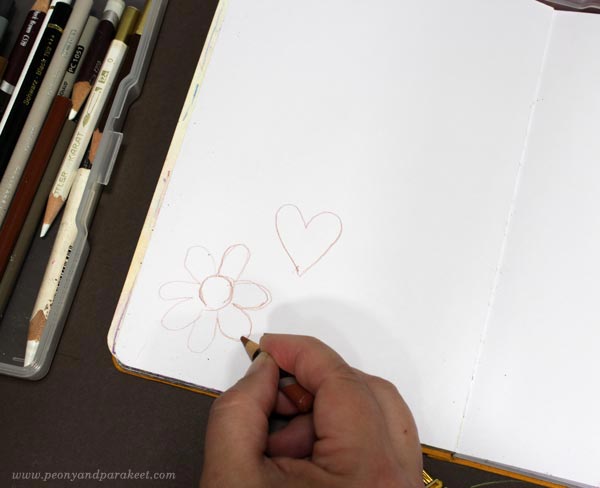
There’s nothing creative here, these are just the basic symbols of a flower and a heart. Place these on the corner of the page so that they are like a starting point for the rest of the image.
Step 2 – Draw a Tilted Flower and a Heart
Now draw a flower and a heart so that they look tilted. Having variation makes the image!
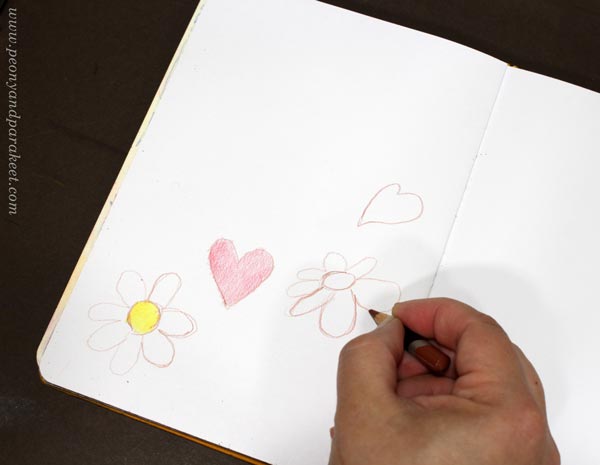
Instead of a circle, draw an oval for the center of the flower. Change the length of the petals gradually. Draw the other side of the heart smaller so that it’s not symmetrical anymore.
I like to add some color right away – not much, just a light layer as a warmup.
Step 3 – Draw a Big Flower and Then a Heart Behind It
I bet your flowers and hearts are pretty similar in size and placed separately – like mine are! Let’s add variation by drawing a big flower and by placing a heart behind it. So here, the heart is only partly visible.
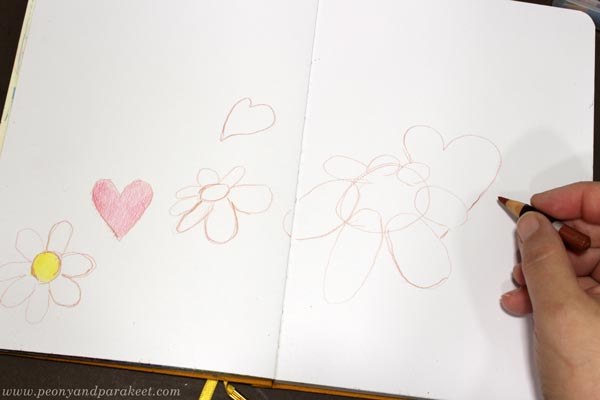
Again, I drew the flower a little differently than before. I made the petals go on the top of the center. Now when the flowers and hearts are all a bit different, they look more lively too.
Step 4 – Color the Hearts and Flowers and the Background Around Them
Now pick a wider selection of pencils and color the hearts and flowers. Also, choose a background color and add some of it to the background.
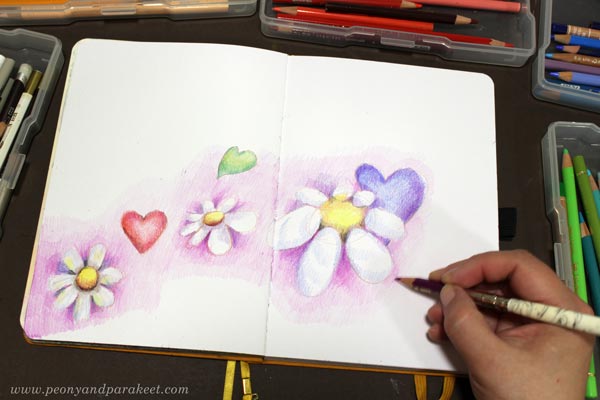
You can adjust the outlines if needed with the background color. Color lightly and leave most of the background blank.
Now you have a cute little drawing, but let’s draw more freely next!
Step 5 – Color Flowers on the Background
We now have stereotypes of flowers, but let’s go further and question them. When a flower wants to be free, it becomes less defined, and the center disappears. Make the background more lively by coloring three big blurry flowers freely.
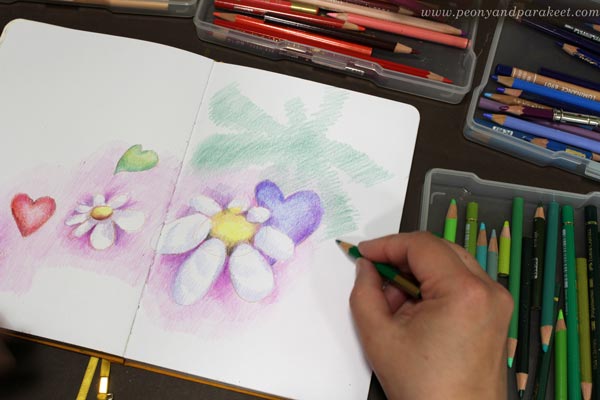
Without thinking about typical flowers, color stripes that go in different directions. They can have different lengths, be straight or curvy, and the result can look pretty odd!
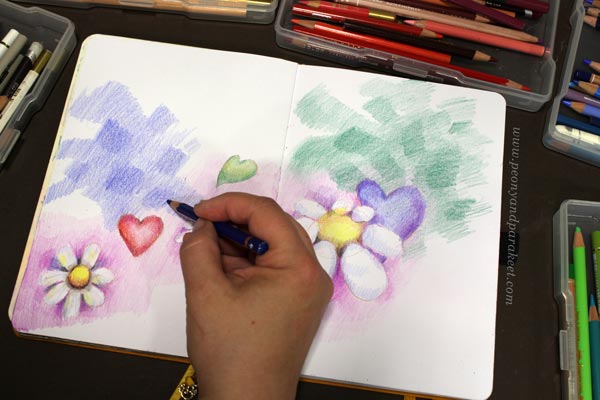
Then color rectangles on the top. Make three blurry flowers total – sets of stripes and rectangles, that is!
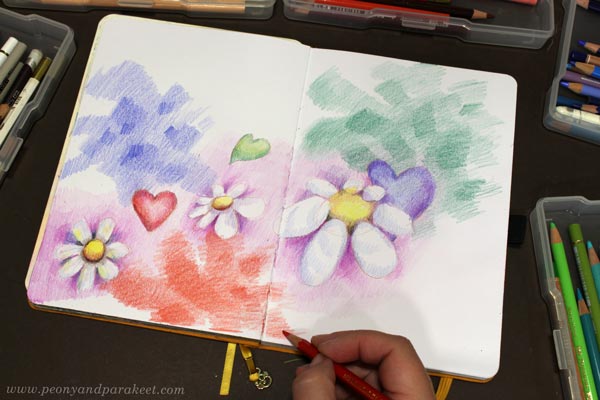
Connect the elements so that the new ones go a little behind the old ones. When you want to create an emotional connection, create a visual connection!
Step 6 – Color Hearts on the Background
Without outlining, color a set of hearts with the background color, and then make a second set of white hearts by coloring the background.
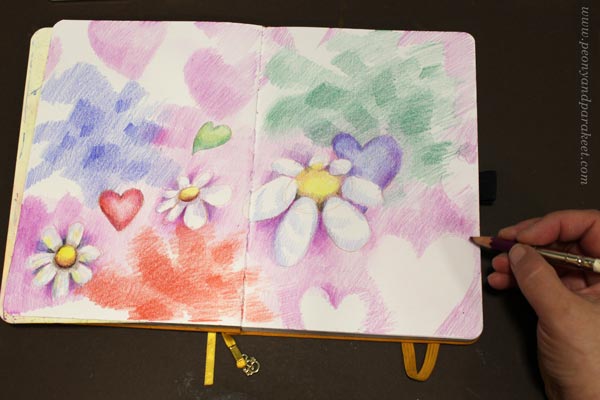
Color around the heart, not the actual heart! The hearts can have various sizes. Place a part of the hearts near the edges so that they are only partly visible.
Then add more background color so that it goes partly over the background elements and makes the image a little darker and calmer.
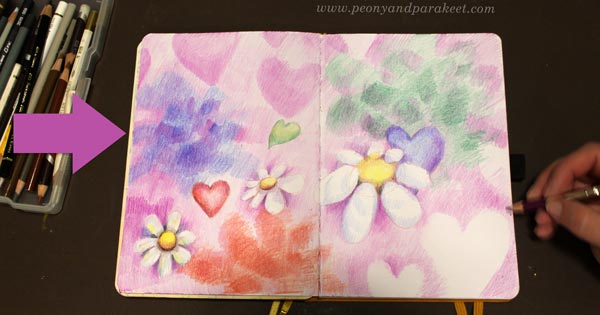
Now you have some free expression, but next, let’s go further and add more drama!
Step 7 – Color a Dark Path
Light always shines more brightly when there are also dark colors. Pick black and other dark pencils and plan a path that goes across your image from one corner to the opposite side of the center.
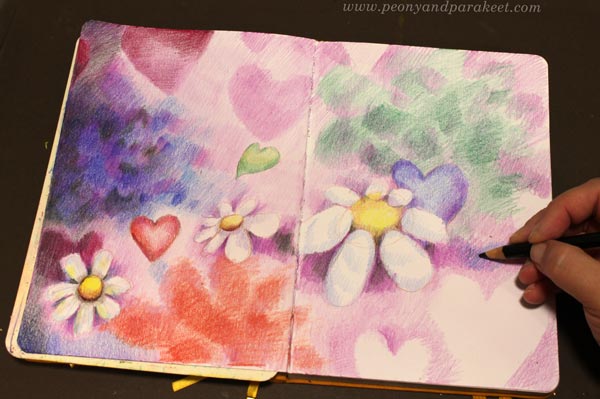
First, color the chosen corner and the nearest edge. Then move towards the center. There, add shorter stripes and spots that mark the path and highlight the best parts of the image.
Now you have set the basic lighting. But in nature, light often travels less straight and makes the overall impression less stiff.
Next, we will get creative and free up the light!
Step 8 – Draw a Freeform Line and Color Its Sides Differently
Take a deep breath, and practice first. Stand up, and move a pencil in the air so that it creates curves. Then sit down and draw a curvy and continuous line that goes across the page.
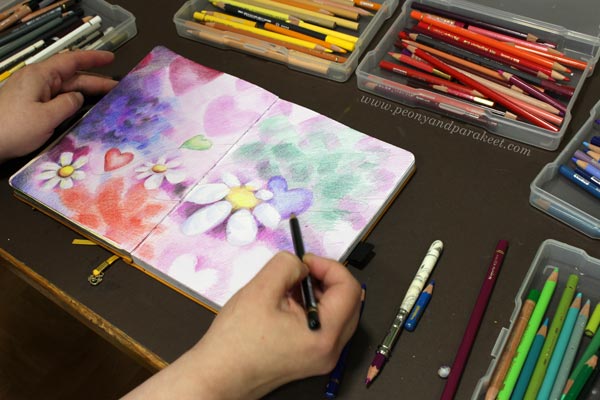
Draw freely and lightly!
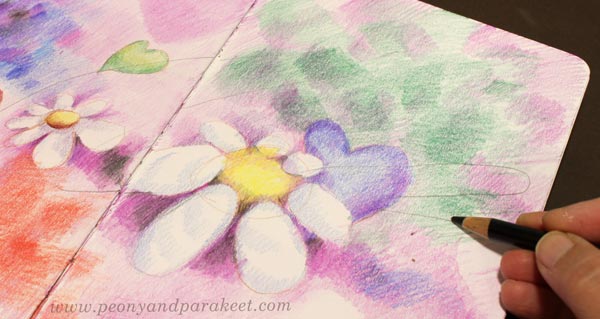
Then color around the line so that light and shadows alternate there. When darkening an area, notice that you can also color smaller shapes and patterns instead of using a solid color.
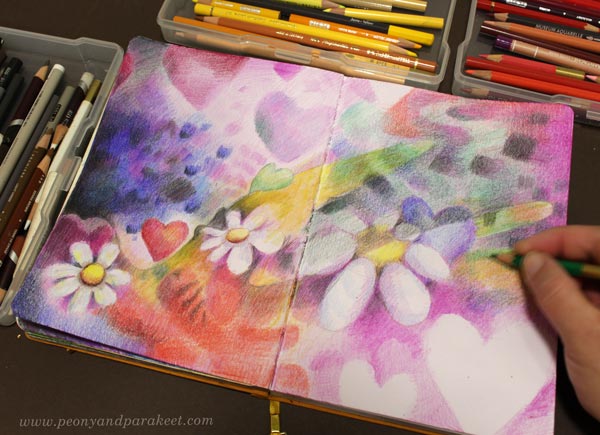
Hearts and flowers can also interact with the division so that they add more little curves to it.
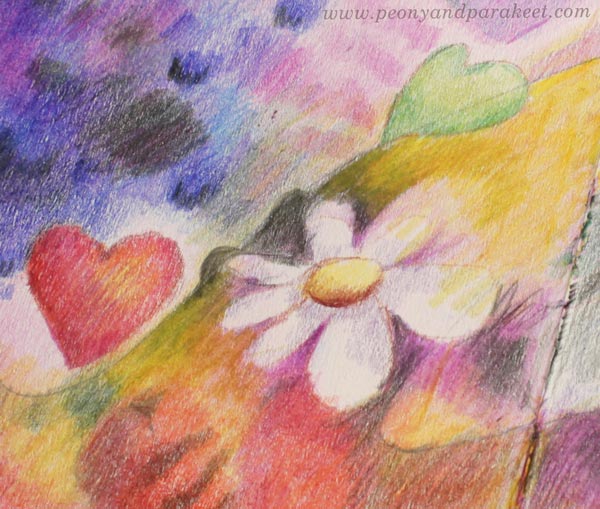
Here, the petals push the line away, creating small bumps.
If you want to add more interest to any other area, you can do the same: draw a line and then color the sides differently.
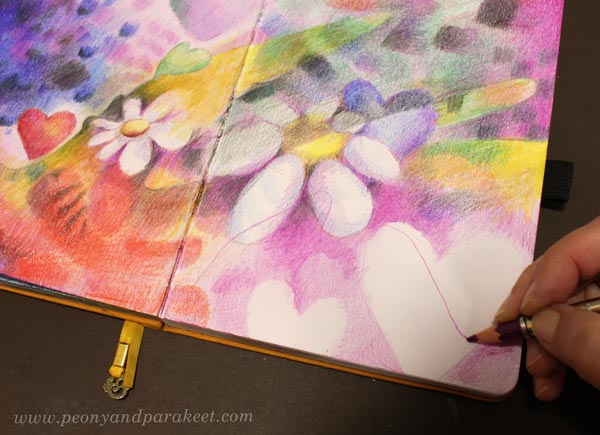
Now you have an atmospheric image, but does it have a message?
Next, let’s ponder what to express and color a little more!
Step 9 – Finishing with a Message
Ask yourself: what element do you like the best? My favorite thing was this blurry heart.
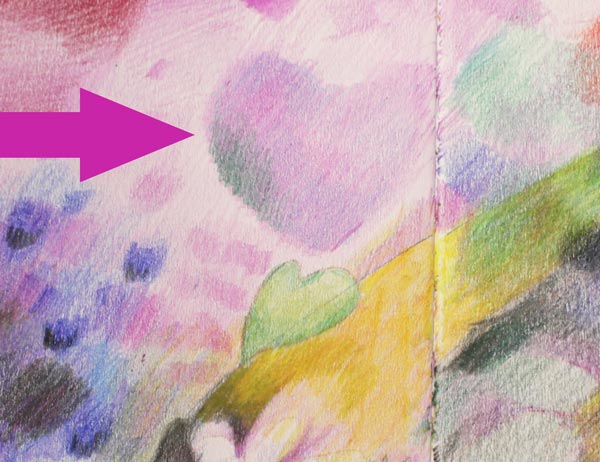
Even if it’s not a centerpiece like the big white flower, it felt like a force that affects the scenery the most. I often discover this kind of “background force” in my drawings and paintings. It seems to be the most strongly connected with the overall message that I want to tell.
The pink heart is like a lady who makes everybody fall in love with her. I want the overall scenery to look feminine but also have elements that include agony and the more desperate side of romantic feelings. I like the tension that I gave with some sharp lines and dramatic curves.
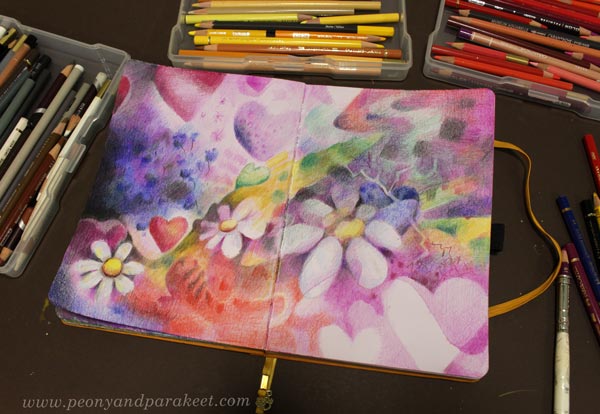
Because everything has two sides, often finishing with the message means adding more tension. It makes the image feel more real and more relatable.
I hope this inspired you to draw freely!
Layering Colored Pencils – Magical Effects Step by Step
This week, I have a new spread for my colored pencil journal, and it’s based on layering colored pencils. I share detailed photos so that you can try this too!
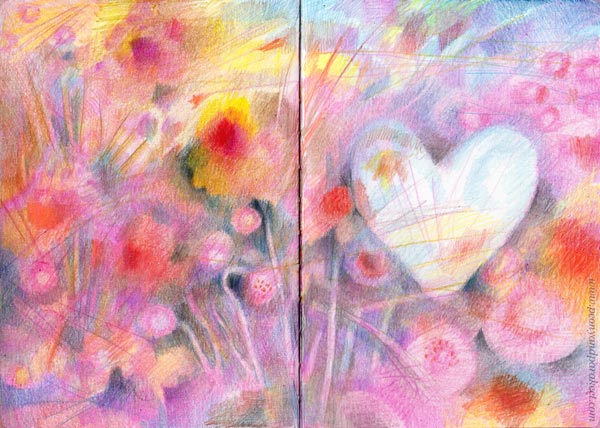
This coloring technique creates magical looseness, even if it begins with very stiff shapes. Because layering the colored pencils is the key here, it’s important to keep the layers light because paper can’t hold color endlessly.
Step 1 – Set Atmosphere
Choose a color that sets the mood for the image. My choice was pink.
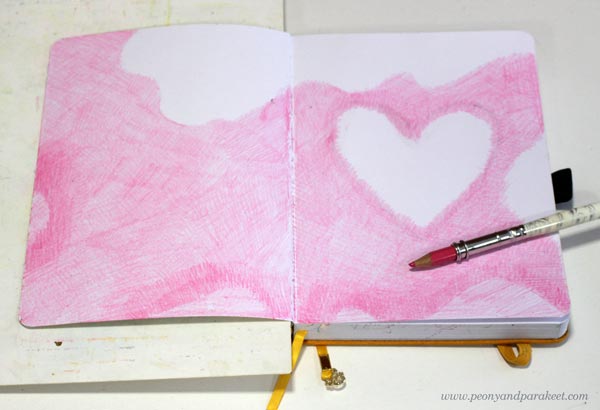
Color the background lightly, but leave some blank areas near the edges and where you want the focal point to be. The heart is my focal point.
The blank parts will allow you to include lovely color variations in the last layers. Color softly and avoid outlines so that the overall feel is magical from the first layer.
Step 2 – Add Pattern
Stick with the same pencil and continue the monotone look by coloring rings on the colored area.
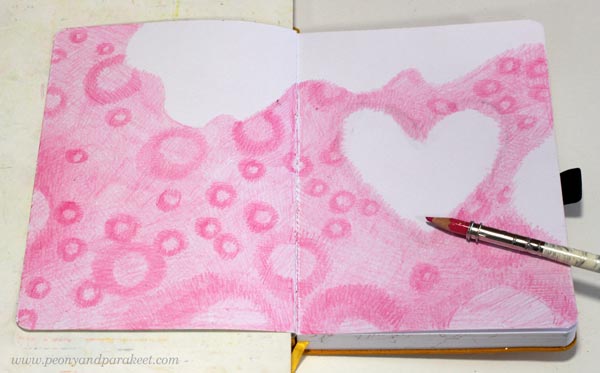
Make sure that the rings are different in size and spread a little unevenly so that the result looks natural and interesting. Think about fabrics but not the easiest polka dots, but a bit more intricate design.
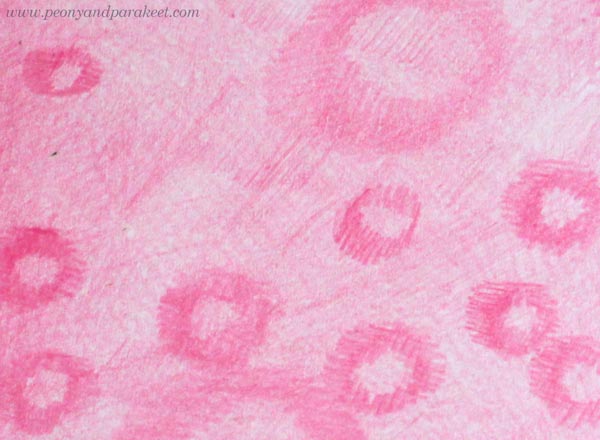
Here’s a closeup of my rings. Again, I don’t use outlines but color them with short strokes that go in many directions.
Step 3 – Destroy
This step could be called “destruction” because now we color random shapes that don’t follow the previous layers at all. Bring in new bright colors. Color stripes, rectangles, random shapes, and lines freely.
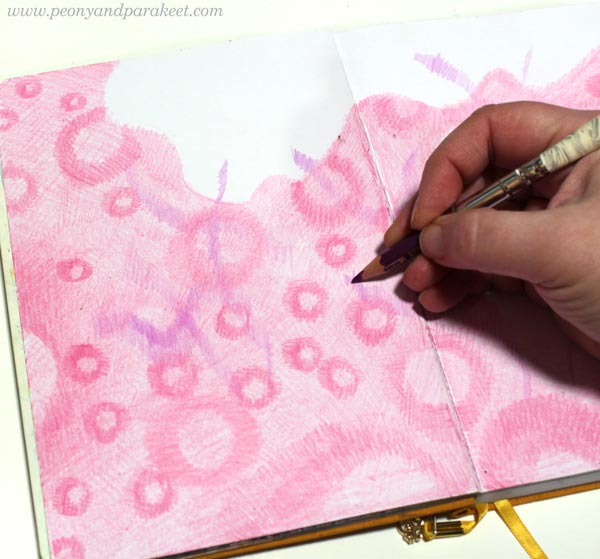
You can go over the blank parts too but keep the focal point a little less untouched.
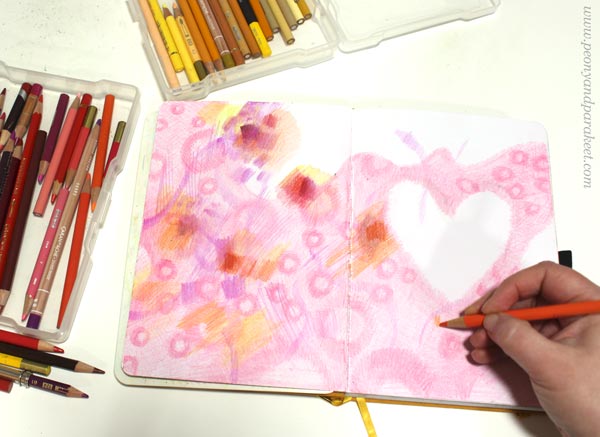
The idea is not to cover previous layers fully but to destroy their rhythm.
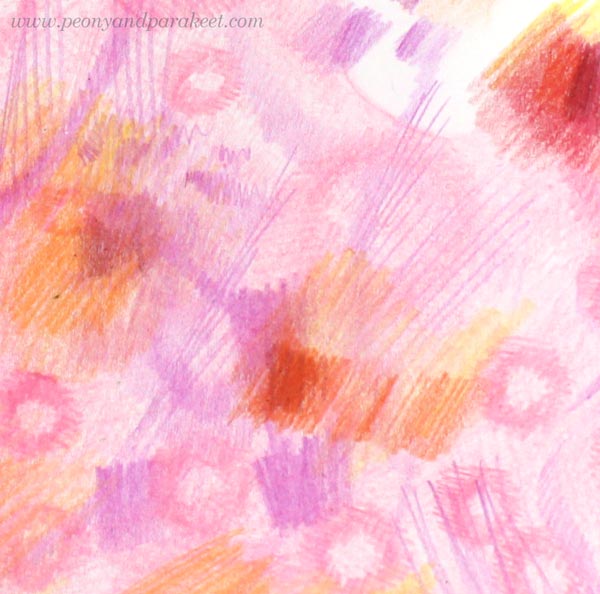
Here’s a closeup of my work. The new shapes and lines have taken over, and the rings are not so well visible anymore.
Step 4 – Discover
Keep coloring, but now bring in darker tones too. Keep the layers light and shapes soft, but when you discover something that you like, highlight its edges with a darker color.
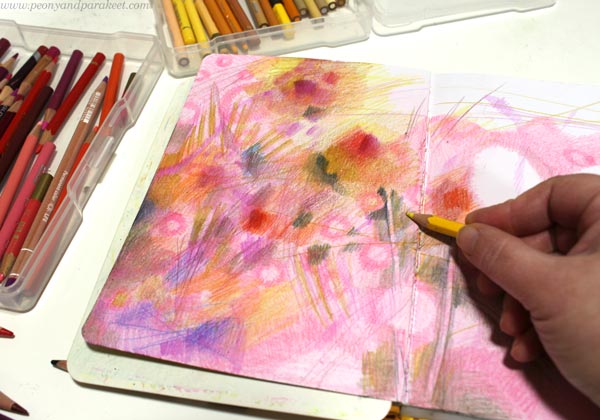
I didn’t use any green pencils in my spread, but it does have some green shades. Mixing black and yellow makes lovely olive green.
Now it’s also the time to bring some rings back to the foreground!
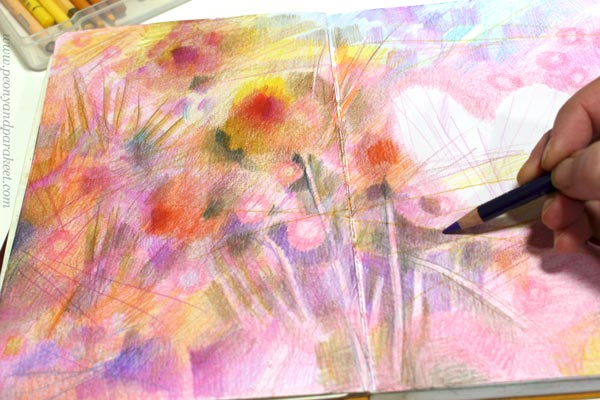
These rings remind me of perennial Bellis flowers!
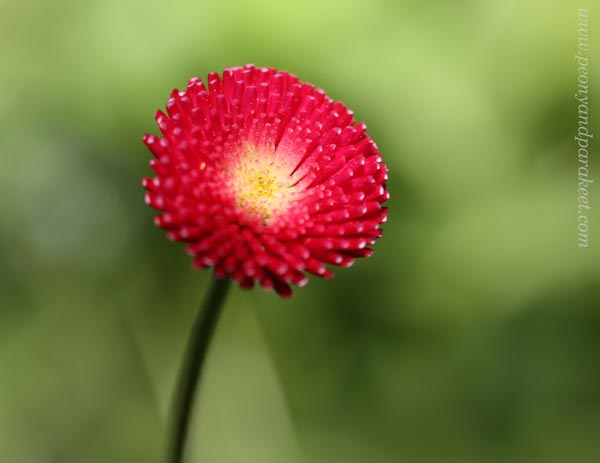
Here’s a closeup of digging out the rings – now flowers – with dark colors.
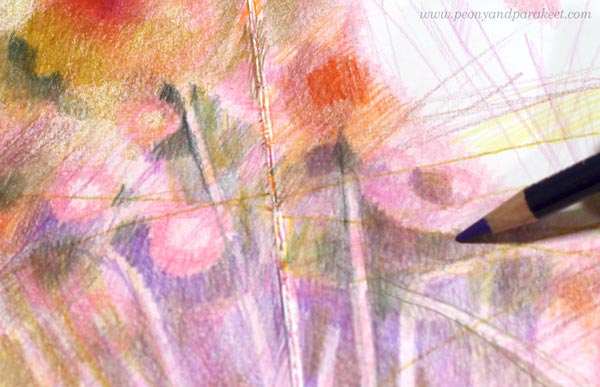
I don’t bring up all the rings, just some! This makes the layered look: some elements are covered and located further in the background, some come up to the foreground. The stiffness of the background pattern looks attractive when it’s combined with looser coloring.
Step 5 – Finish with Message
Your work will be finished when it delivers a message. The focal point, the heart in my case, is essential for achieving this. I like to work intuitively so that I don’t try to define the message right from the beginning but let the insight grow with the coloring. Here, I left the heart light and made it look icy and magical.
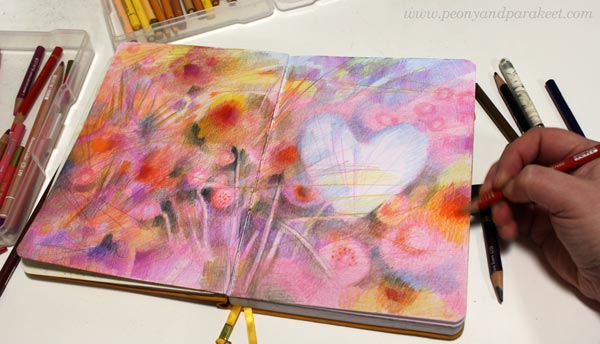
First, I thought about this winter, how tough it has been to walk the dogs on icy roads, and how much I want spring to come. And then it hit me how ice must mourn when its life is coming to an ending. How between the first flowers, there’s a little block of ice, looking around, feeling isolated.
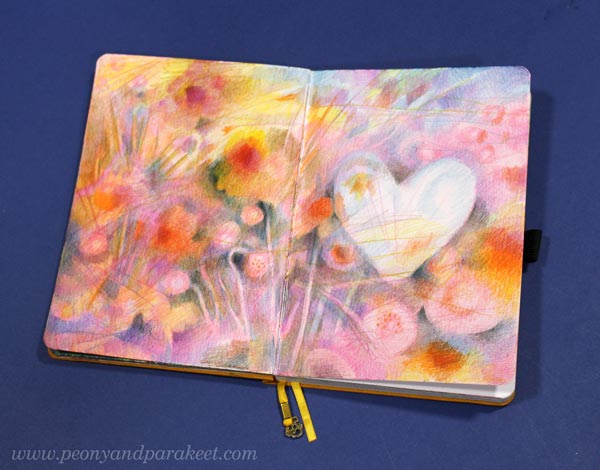
This little frozen heart is like a rare unicorn – reflecting the surroundings, introvertedly, like we all do when we are creating.
I find this kind of pondering an important part of art-making. That’s why I always try to end with a message even if viewers can freely find their explanations as well.
Fun Botanicum – Sign up Now!
From March 15 to May 15, 2022, I run an online class for us who are inspired by nature and fantasy and love plants. The class is called Fun Botanicum and we will draw fantasy plants by scribbling, doodling, and layering with colored pencils. Join us!
The early-bird sale ends soon! Early-bird price: 59 EUR, now 49 EUR. >> Sign Up Now!
The sale ends on Feb 20, 2022, at midnight PST.
Wild Botanical Art – Create with Colored Pencils and Watercolors
This week, I created wild botanical art. I drew plants with delicate details like in botanical illustrations, but with a few differences. My plants are not any real species, and the jungle where they grow is more like my inner world at its best, not a real location on the planet.
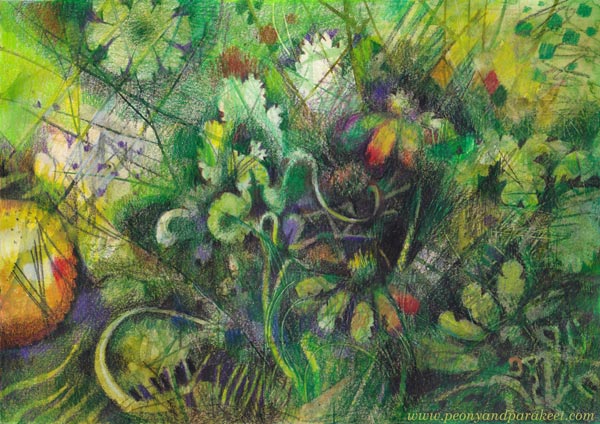
Watercolors First!
Before putting colored pencils into work, I made some backgrounds with watercolors. I had very smooth watercolor paper – hot press quality. My friend Eeva Nikunen recommended Arches Hot Press paper that she has used for detailed graphite drawings. It’s a bit pricey but so smooth and lovely for colored pencils too. However, any smooth watercolor paper would work with this technique.
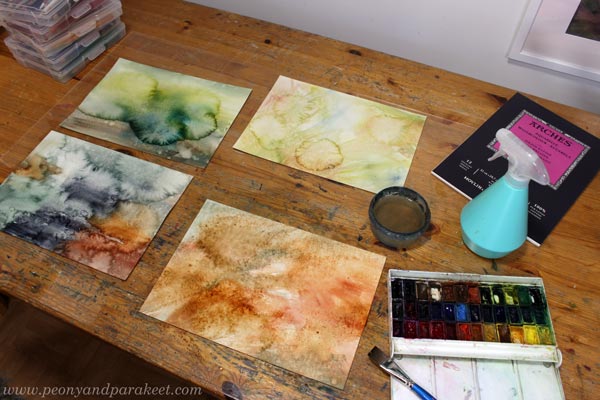
I used a lot of water for the first layer and made random splotches with a spraying bottle. This kind of wild watercolor painting is fun, but when I tried to pick one of the four experiments for colored pencils, I found the results uninspiring. So I asked myself what kinds of nature’s shapes or colors would I want to see more, and answered: “All kinds of hays inspire me a lot!”
Love for Sharp-Shaped Botanicals
We have lots of house plants that have sharp leaves.
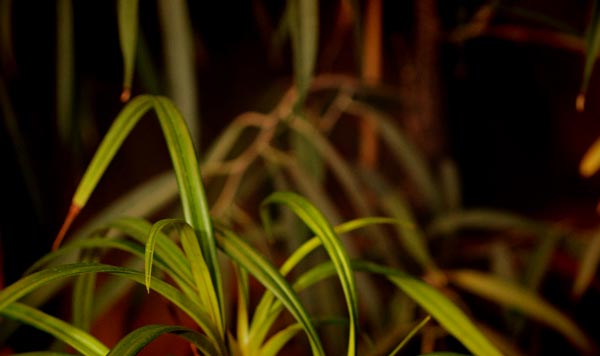
And when I walk in nature, I always look for hays and how light hits them.
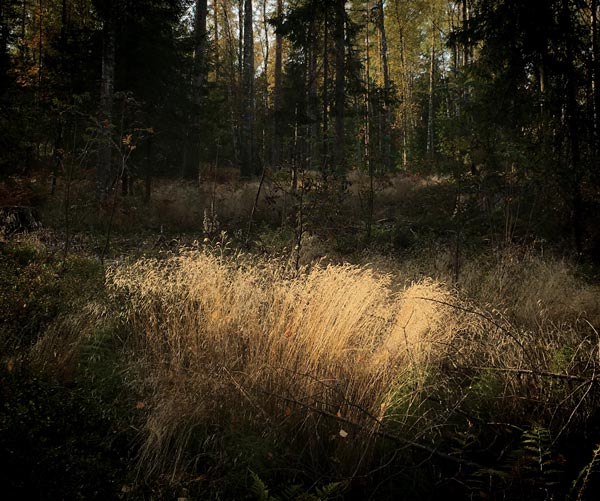
So, then after some drying time, I made thin lines that went wildly here and there.
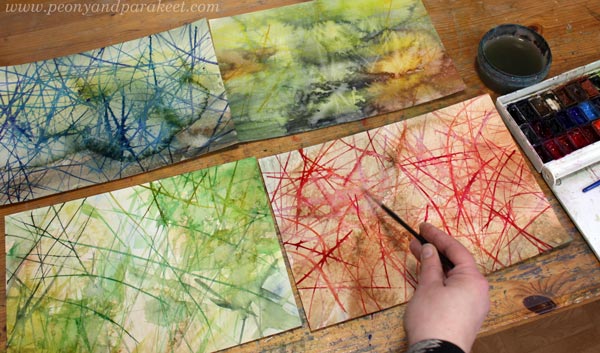
After the lines, I found the green one on the bottom left very inviting, so I chose that for coloring.
Coloring Freely and Wildly
Colored pencils work well on the watercolor background and smooth paper. It was enjoyable to color freely. I didn’t follow the shapes or lines painted in watercolor but created new layers.
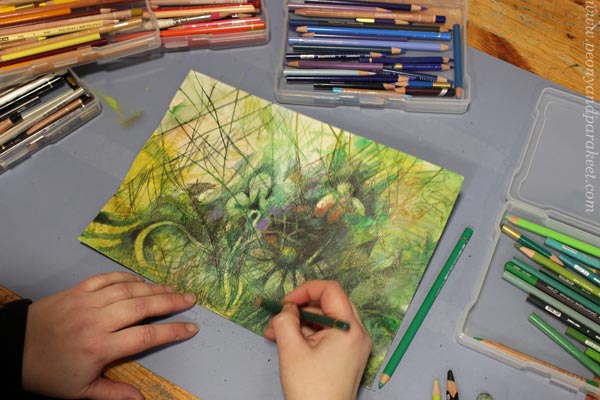
I have started to store my colored pencils in shallow plastic boxes grouped in color families. This way, every pencil gets seen, and the differences between tones are easy to identify.
Should Plant People Draw Plants?
My husband and I are plant people. Our home is filled with house plants and we have all kinds of plants in our garden. It has been quite a job to save the plants from our new puppy Saima!
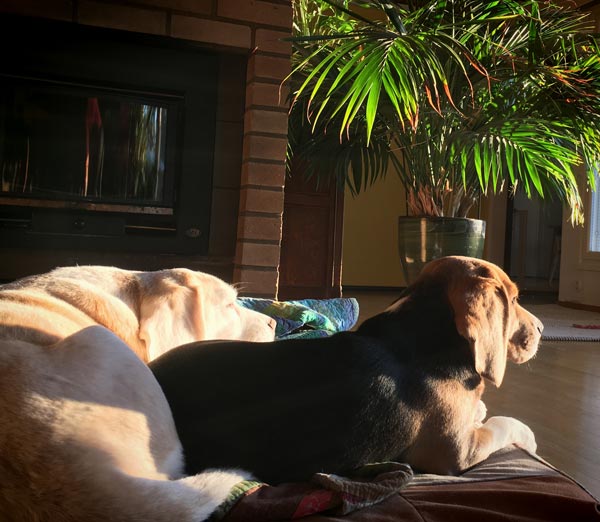
Plants have also always been present in my paintings. But recently, I have thought that maybe I could focus more on them with colored pencils too. It often feels that I come home when I am inspired by plants and travel abroad when I am creating something else. I want to challenge myself out of my comfort zone, but if there’s a strong resonation, like a secret companionship, should I listen to it?
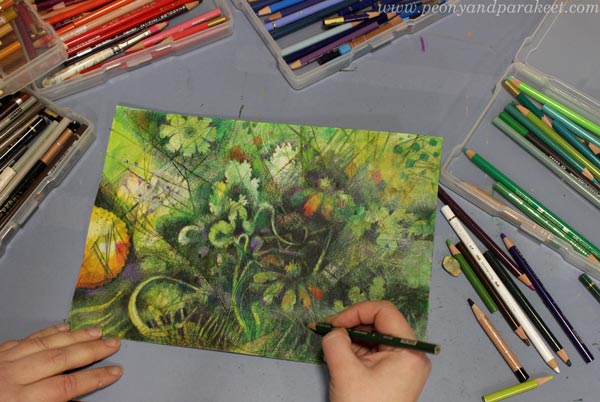
More Wild Botanical Art – Playing Mode On!
It was so much fun to work on this project that I wanted to do more. So, I colored these small scraps – a fruit and a leaf!
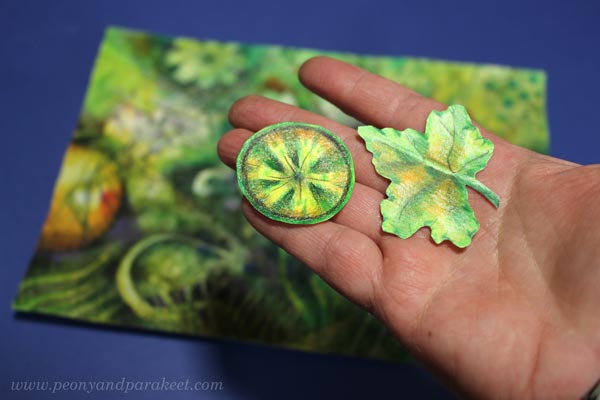
And then it was playing time. How wild can this go?
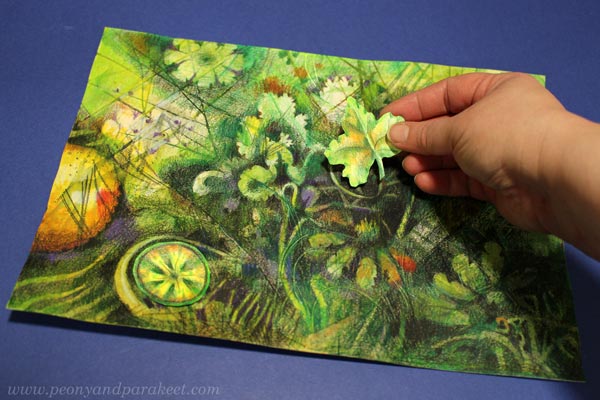
Create Wild Botanical Art – Five Tips!
- Start by creating a wilderness that calls you.
- Color layers of random shapes and lines. When you see something that could be a plant, turn it into one!
- Don’t worry about identifying the plants – treat them as rarities that only you can find!
- Make detailed a little more detailed – botanical art goes crazy with details!
- Revamp – Add some plants from your box of joy!
- Bonus tip: Nature is full of curves, so make sure you also have some.
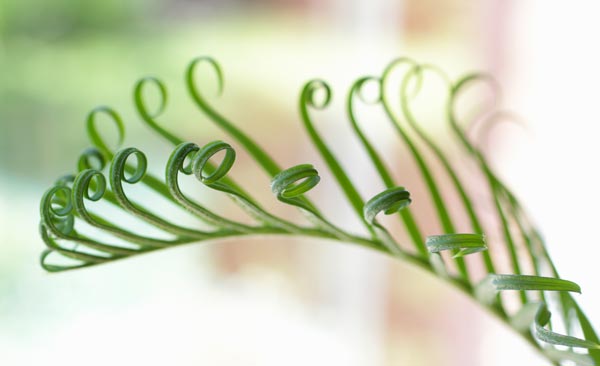
Botanical Art by Ernst Haeckel
Many years ago, a blog reader mentioned Ernst Haeckel’s botanical art. Since then, I have admired his work. Here’s a part of his illustration from 1904. Lots of greens spiced with warm colors and so many details!
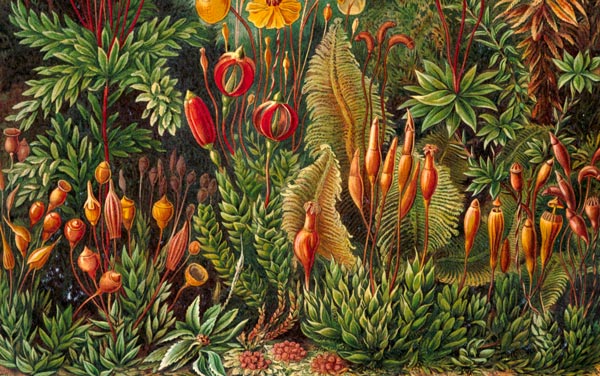
Mine is not nearly as sharp and detailed as Haeckel’s, but I approve it anyway. Plants have different personalities, and so do their interpretations!
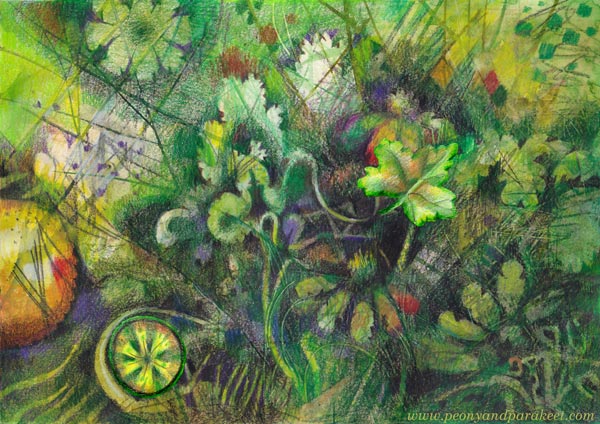
Tell me, do you like drawing plants? What kinds of plants especially?
New Free Mini-Course for Subscribers
Great news! I have updated the free mini-course “Paint the Emotion” and it’s now called “Color the Emotion.” I have added a new project with colored pencils and more talk about how to approach art-making. The mini-course is about 40-minutes long and it’s available for all the subscribers of my weekly emails.
Here I am talking about the free mini-course in a video:
P.S. If you are already subscribed, no worries! I will send you an email today with the link to the mini-course!